FY2013 Science Highlights
View Highlights from other years: Recent Highlights | FY2012 | Archives
ALMA Opens a New Window on Supernova Ejecta
![A color composite image of SN 1987A. The unresolved 12CO 2-1 line emission detected by ALMA (red). The red ellipse at lower is the synthesized beam. Note also the H emission (blue), and the [Si I] + [Fe II] 1.644 micron emission (green in the ring; yellow in the ejecta) observed with HST (Larsson et al. 2013).](https://science.nrao.edu/science/highlights/images/fy2013/alma_supernova_ejecta.jpg/@@images/93bdf07e-44ad-44f8-b65e-8771c497194b.jpeg) ALMA’s unprecedented sensitivity and resolution have enabled scientists to identify CO and SiO in the Supernova (SN) 1987A inner ejecta. The C/O clumps in SN1987A contain at least 0. 01 M⊙ of 12CO, an order of magnitude greater amount than measured in the first few years after the explosion. 12CO has clearly continued to form over the past 25 years. This CO is at T > 14K, is confined within at most 35% of a spherical volume expanding at 2000 km/sec. The emission is located within 1 arcsecond of the central debris.
ALMA’s unprecedented sensitivity and resolution have enabled scientists to identify CO and SiO in the Supernova (SN) 1987A inner ejecta. The C/O clumps in SN1987A contain at least 0. 01 M⊙ of 12CO, an order of magnitude greater amount than measured in the first few years after the explosion. 12CO has clearly continued to form over the past 25 years. This CO is at T > 14K, is confined within at most 35% of a spherical volume expanding at 2000 km/sec. The emission is located within 1 arcsecond of the central debris.
ALMA views the full velocity range of emission, unobscured by dust. Doppler tomography will be possible in CO and other molecules (SiO) to probe the spatial, chemical, and kinetic environment within the inner ejecta.
Figure: A color composite image of SN 1987A. [Red] The unresolved 12CO 2-1 line emission detected by ALMA. The red ellipse at lower is the synthesized beam. [Blue] H emission. The [Si I] + [Fe II] 1.644 micron emission [Green in the ring; Yellow in the ejecta] observed with HST (Larsson et al. 2013).
View Publication: Carbon Monoxide in the Cold Debris of Supernova 1987A, J. Kamenetzky (Colorado-Boulder), R. McCray (Colorado-Boulder), R. Indebetouw (Virginia, NRAO), M. J. Barlow (University College-London), M. Matsuura (University College-London), M. Baes (Gent), J.A.D.L. Blommaert (KU Leuven. Vrije), A. Bolatto (Maryland), L. Decin (KU Leuven), L. Dunne (Canterbury), C. Fransson (Stockholm), J. Glenn (Colorado-Boulder) , H. L. Gomez (Cardiff), M.A.T. Groenewegen ((Royal Obs-Belgium), R. Hopwood (Imperial College-London), R.P. Kirshner (Harvard), M. Lakicevic (Keele), J. Marcaide (Valencia), I. Marti-Vidal (Onsala), M. Meixner (STScI), P. Royer (KU Leuven), A. Soderberg (Harvard), G. Sonneborn (NASA-Goddard), L. Staveley-Smith (ICRAR,CAAS-TRO), B. M. Swinyard (University College-London), G. Van de Steene (Royal Obs-Belgium), P.A.M. van Hoof (Royal Obs-Belgium), J. Th. van Loon (Keele), J. Yates (University College-London), G. Zanardo, (CAAS-TRO), 2013 ApJ Letters, 773, L34 (20 August 2013).
Imaging of the CO Snow Line in a Solar Nebula Analog
 ALMA has imaged the CO “snow line” around TW Hya, an analog of the solar nebula. Planets form in the disks around young stars. Their formation efficiency and composition are intimately linked to the protoplanetary disk locations of snow lines of abundant volatiles. The chemical imaging used high spatial and spectral resolution observations of N2H+, a reactive ion present in large abundance only where CO is frozen out. The N2H+ emission is distributed in a large ring, with an inner radius that matches CO snow line model predictions. The extracted CO snow line radius of ~ 30 AU is a key parameter in constraining models of the formation dynamics of planetary systems.
ALMA has imaged the CO “snow line” around TW Hya, an analog of the solar nebula. Planets form in the disks around young stars. Their formation efficiency and composition are intimately linked to the protoplanetary disk locations of snow lines of abundant volatiles. The chemical imaging used high spatial and spectral resolution observations of N2H+, a reactive ion present in large abundance only where CO is frozen out. The N2H+ emission is distributed in a large ring, with an inner radius that matches CO snow line model predictions. The extracted CO snow line radius of ~ 30 AU is a key parameter in constraining models of the formation dynamics of planetary systems.
Figure: ALMA and Submillimeter Array images of dust, CO and N2H+ emission toward TW Hya. The red circle is the CO snow line prediction.
View Publication: Imaging of the CO Snow Line in a Solar Nebula Analog, Chunhua Qi (CfA), Karin I. Oberg (Virginia), David J. Wilner (CfA), Paolo D’Alesso (UNAM), Edwin Bergin (Michigan), Sean M. Andrews (CfA), Geoffrey A. Blake (Caltech), Michiel R. Hogerheijde (Leiden), Ewine F. van Dishoeck (Leiden, MPIfE), Science, 341, 630 (9 August 2013). Published in Science Express 18 July 2013.
View 18 July 2013 Press Release
A Galaxy-scale Molecular Outflow
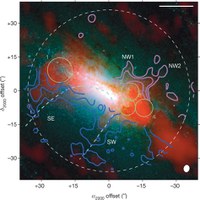 ALMA has imaged expanding molecular shells in the starburst nucleus of NGC 253 at 50 parsec resolution. The extra-planar molecular gas closely tracks the Hα filaments, and connects to expanding molecular shells located in the starburst region. The molecular outflow rate is 9 M⊙ per year, implying a ratio of mass-outflow rate to star-formation rate of ~3, indicating that the starburst-driven wind limits the star-formation activity and the final stellar content. These observations support the idea that the growth of large galaxies may be limited by strong wind-driven outflows.
ALMA has imaged expanding molecular shells in the starburst nucleus of NGC 253 at 50 parsec resolution. The extra-planar molecular gas closely tracks the Hα filaments, and connects to expanding molecular shells located in the starburst region. The molecular outflow rate is 9 M⊙ per year, implying a ratio of mass-outflow rate to star-formation rate of ~3, indicating that the starburst-driven wind limits the star-formation activity and the final stellar content. These observations support the idea that the growth of large galaxies may be limited by strong wind-driven outflows.
Figure: Blue and magenta contours are CO emission at +/- 100 km/s around the NGC 253 nucleus.
View Publication: Suppression of Star Formation in the Galaxy NGC 253 by a Starburst-driven Molecular Wind, Alberto D. Bollato (Maryland), Steven R. Warren (Maryland), Adam K. Leroy (NRAO), Fabian Walter (MPIfA), Sylvain Veilleux (Maryland), Eve C. Ostriker (Princeton), Jürgen Ott (NRAO), Martin Zwaan (ESO), David B. Fisher (Maryland), Axel Weiss (MPIfR), Erik Rosolowsky (British Columbia), and Jacqueline Hodge (MPIfA), 2013 Nature 499, 450 (25 July 2013).
View 24 July 2013 Press Release
An HI Pilot Deep Field
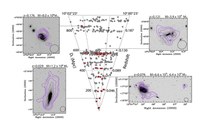 The Jansky VLA has been used for a deep pilot search for neutral hydrogen in distant galaxies. Part of the COSMOS field was observed for 50 hours, and 33 galaxies were detected in HI to z = 0.2, including three without a previously known spectroscopic redshift. The detections have a range of HI and stellar masses, indicating the diversity of galaxies probed. This pilot study shows that the VLA B-array is the ideal configuration for H I deep fields, and that the VLA is ready a very deep HI survey, as a key pathfinder for the Square Kilometre Array.
The Jansky VLA has been used for a deep pilot search for neutral hydrogen in distant galaxies. Part of the COSMOS field was observed for 50 hours, and 33 galaxies were detected in HI to z = 0.2, including three without a previously known spectroscopic redshift. The detections have a range of HI and stellar masses, indicating the diversity of galaxies probed. This pilot study shows that the VLA B-array is the ideal configuration for H I deep fields, and that the VLA is ready a very deep HI survey, as a key pathfinder for the Square Kilometre Array.
Figure: Sample detections in the Jansky VLA pilot HI deep field.
View Publication: A Pilot for a Very Large Array H I Deep Field, Ximena Fernandez (Columbia), J.H. van Gorkum (Columbia), Kelley M. Hess (Cape Town), D.J. Pisano (WVU, NRAO), Kathryn Kreckel (MPIfA), Emmanuel Momjian (NRAO), Attila Popping (ICRAR), Tom Oosterloo (ASTRON, Groningen), Laura Chomiuk (Michigan State), M.A.W. Verheijen (Groningen), Patricia A. Henning (New Mexico), David Schiminovich (Columbia), Matthew A. Bershady (Wisconsin), Eric M. Wilcots (Wisconsin), and Nick Scoville (Caltech), 2013 ApJ Letters, 770, L29 (20 June 2013).
Gould's Belt VLA Survey: The Ophiuchus Complex
 Large-scale (2000 square arcmin), deep (20 micro-Jy), high-resolution (1 arcsec) Jansky VLA observations of the Ophiuchus star-forming complex from 4 to 6 cm are presented. A total of 189 sources were detected: 56 associated with known young stellar sources; 4 with known extragalactic objects; the other 129 remain unclassified, but most of them are most probably background quasars. The vast majority of the young stars detected at radio wavelengths have spectral types K or M, although 4 objects of A/F/B spectral type and 2 brown dwarf candidates were also detected. At least half of these young stars are non-thermal, gyro-synchrotron sources, with active coronas characterized by high levels of variability, negative spectral indices and, in some cases, significant circular polarization. As expected, there is a clear tendency for the fraction of non-thermal sources to increase from the younger (Class 0/I or flat spectrum) to the more evolved (Class III or weak-line T Tauri).
Large-scale (2000 square arcmin), deep (20 micro-Jy), high-resolution (1 arcsec) Jansky VLA observations of the Ophiuchus star-forming complex from 4 to 6 cm are presented. A total of 189 sources were detected: 56 associated with known young stellar sources; 4 with known extragalactic objects; the other 129 remain unclassified, but most of them are most probably background quasars. The vast majority of the young stars detected at radio wavelengths have spectral types K or M, although 4 objects of A/F/B spectral type and 2 brown dwarf candidates were also detected. At least half of these young stars are non-thermal, gyro-synchrotron sources, with active coronas characterized by high levels of variability, negative spectral indices and, in some cases, significant circular polarization. As expected, there is a clear tendency for the fraction of non-thermal sources to increase from the younger (Class 0/I or flat spectrum) to the more evolved (Class III or weak-line T Tauri).
Figure: Location of the YSOs (blue circles) and candidate YSOs (green circle) on the Ophiuchus complex extinction map. The position of the new calibrator detected is indicated by the brown square in the Ophiuchus core.
View Publication: The Gould's Belt Very Large Array Survey I: The Ophiuchus Complex, Sergio A. Dzib (UNAM), Laurent Loinard (UNAM, MPIfR), Amy Mioduszewski (NRAO), Luis Rodriguez (UNAM. King Abdulaziz), Gisela N. Ortiz-Leon (UNAM), Gerardo Pech (UNAM), Juana L. Rivera (UNAM), Rosa M. Torres (Santiago), Andrew F. Boden (Caltech), Lee Hartmann (Michigan), Neal J. Evans II (Texas), Cesar Briceno (Venezuela), and John Tobin (NRAO), 2013 ApJ, 775, 63 (20 September 2013).
Imaging Quasar Host Galaxies
 The authors present ALMA observations of the [C II] 158 μm fine structure line and dust continuum emission from the host galaxies of five redshift 6 quasars. They also report complementary observations of 250 GHz dust continuum and CO (6-5) line emission from the z = 6.00 quasar SDSS J231038.88+185519.7 using IRAM. The ALMA observations were carried out in the extended array at 0.''7 resolution, and ALMA detected the line and dust continuum in all five objects. The derived [C II] line luminosities are 1.6 × 109 to 8.7 × 109 L⊙ and the [C II]-to-FIR luminosity ratios are 2.9-5.1 × 10-4, which is comparable to the values found in other high-redshift quasar-starburst systems and local ultra-luminous infrared galaxies. The sources are marginally resolved and the intrinsic source sizes (major axis FWHM) are constrained to be 0.3-0.6 arcsec (1.7-3.5 kpc) for the [C II] line emission and 0.2-0.4 arcsec (1.2-2.3 kpc) for the continuum. These measurements indicate that there is vigorous star formation over the central few kpc in the quasar host galaxies. The ALMA observations also constrain the dynamical properties of the star-forming gas in the nuclear region. The intensity-weighted velocity maps of three sources show velocity gradients that are consistent with a rotating, gravitationally bound gas component. Under the simplifying assumption of rotation, the implied dynamical masses within the [C II]-emitting regions are of order 1010-1011 M⊙. Given these estimates, the mass ratios between the supermassive black holes and the spheroidal bulge are an order of magnitude higher than the mean value found in local spheroidal galaxies, in agreement with results from previous CO observations of high redshift quasars.
The authors present ALMA observations of the [C II] 158 μm fine structure line and dust continuum emission from the host galaxies of five redshift 6 quasars. They also report complementary observations of 250 GHz dust continuum and CO (6-5) line emission from the z = 6.00 quasar SDSS J231038.88+185519.7 using IRAM. The ALMA observations were carried out in the extended array at 0.''7 resolution, and ALMA detected the line and dust continuum in all five objects. The derived [C II] line luminosities are 1.6 × 109 to 8.7 × 109 L⊙ and the [C II]-to-FIR luminosity ratios are 2.9-5.1 × 10-4, which is comparable to the values found in other high-redshift quasar-starburst systems and local ultra-luminous infrared galaxies. The sources are marginally resolved and the intrinsic source sizes (major axis FWHM) are constrained to be 0.3-0.6 arcsec (1.7-3.5 kpc) for the [C II] line emission and 0.2-0.4 arcsec (1.2-2.3 kpc) for the continuum. These measurements indicate that there is vigorous star formation over the central few kpc in the quasar host galaxies. The ALMA observations also constrain the dynamical properties of the star-forming gas in the nuclear region. The intensity-weighted velocity maps of three sources show velocity gradients that are consistent with a rotating, gravitationally bound gas component. Under the simplifying assumption of rotation, the implied dynamical masses within the [C II]-emitting regions are of order 1010-1011 M⊙. Given these estimates, the mass ratios between the supermassive black holes and the spheroidal bulge are an order of magnitude higher than the mean value found in local spheroidal galaxies, in agreement with results from previous CO observations of high redshift quasars.
Figure: [Left] Dust continuum, [Center] integrated [CII], and [Right] [CII] velocity images of a z=6.00 quasar.
View Publication: Star Formation and Gas Kinematics of Quasar Host Galaxies at z ~ 6: New Insights from ALMA, Ran Wang (NRAO, Arizon), Jeff Wagg (ESO), Chris L. Carilli (NRAO), Fabian Walter (MPIfA), Lindley Lentati (Cambridge), Xiaohui Fan (Arizona), Dominik A. Riechers (Cornell), Frank Bertoldi (Bonn), Desika Narayanan (Arizona), Michael A. Strauss (Princeton), Pierre Cox (IRAM), Alain Omont (CNRS), Karl M. Menten (MPIfR), Kirsten K. Knudsen (Onsala), Roberto Neri (IRAM), and Linhua Jiang (Arizona State), 2013 ApJ, 773, 44 (10 August 2013).
Added 24 Jul 2014
Gas Motions Feeding the Galactic Center
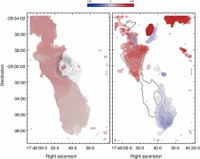 GBT has mapped NH3 over a region around the Galactic Center with the greatest sensitivity, the largest velocity range, and the highest velocity resolution to date. Using these data, Minh et al. have discovered evidence of the interaction of the main molecular clouds with activity in the nucleus as well as new “streaming components” that may be feeding the circum-nuclear disk.
GBT has mapped NH3 over a region around the Galactic Center with the greatest sensitivity, the largest velocity range, and the highest velocity resolution to date. Using these data, Minh et al. have discovered evidence of the interaction of the main molecular clouds with activity in the nucleus as well as new “streaming components” that may be feeding the circum-nuclear disk.
Figure: Color-coded velocity channel NH3 (6, 6) maps. The velocity width of each channel is ~4.6 km/s, and the boundary of the colored feature is for the contour level of 0.5 K km/s for all channels. The 90 cm continuum emission is inserted in the left panel: the boundaries of Sgr A West and Sgr A∗ are green and magenta, respectively. The right-panel contours are for the velocity-integrated intensity of the left panel.
View Publication: Green Bank Telescope Observations of the NH3 (3, 3) and (6, 6) Transitions Toward Sagittarius A Molecular Clouds, Young Choi Minh (Korea Astronomy & Space Science Institute), Hauyu Baobab Liu (ASIAA), Paul T.P. Ho (ASIAA), Pei-Ying Hsieh (ASIAA), Yu-Nung Su (ASIAA), Sungsoo S. Kim (Kyung Hee Univ), and Melvyn Wright (Berkeley), 2013 ApJ, 773, 31 (10 August 2013).
Shocked Gas in the Central Molecular Zone
 Mills & Morris used the GBT to map seven metastable NH3 transitions toward 17 positions in the Central Molecular Zone (CMZ) and have discovered widespread indications of hot molecular gas at T~400 K throughout the region (blue circles in Figure). There is, however, no evidence of heating by stars, and VLA data show that the emission is extended. This implies that much of the CMZ molecular gas is subject to strong internal shocks and ~ 10% is within a post-shock zone at any time.
Mills & Morris used the GBT to map seven metastable NH3 transitions toward 17 positions in the Central Molecular Zone (CMZ) and have discovered widespread indications of hot molecular gas at T~400 K throughout the region (blue circles in Figure). There is, however, no evidence of heating by stars, and VLA data show that the emission is extended. This implies that much of the CMZ molecular gas is subject to strong internal shocks and ~ 10% is within a post-shock zone at any time.
Figure: Positions of the observed NH3 spectra overlaid on a Bolocam 1.1 mm image of the CMZ (Bally et al. 2010). Blue circles represent positions where NH3 (9, 9) is detected; red circles represent non-detections.
View Publication: Detection of Widespread Hot Ammonia in the Galactic Center, E.A.C. Mills (UCLA) and M.R. Morris (UCLA), 2013 ApJ, 772, 105 (1 August 2013).
Rapid Assembly of a Massive Elliptical Galaxy
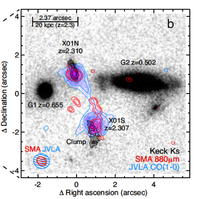 Previous work has shown that massive elliptical galaxies formed rapidly about ten billion years ago with star-formation rates of above several hundred solar masses per year. Fu et al. report multi-wavelength high-resolution observations, including CO observations with the VLA and GBT, of a rare merger of two massive, submillimeter bright galaxies at z = 2.3 that is forming stars at 2,000 M⊙ per year. The observed star-formation efficiency is an order of magnitude greater than that of normal galaxies, and thus the gas reservoir for this star formation will be exhausted in only ~200 million years. At a projected separation of 19 kiloparsecs, the two massive submillimeter galaxies are about to merge and form a passive elliptical galaxy with a stellar mass of ~4x1011 M⊙. The VLA CO results show a tidal structure, direct evidence for a gas-rich major merger, driving the intense star formation during the rapid formation of the most massive elliptical galaxies by z ~ 1.5.
Previous work has shown that massive elliptical galaxies formed rapidly about ten billion years ago with star-formation rates of above several hundred solar masses per year. Fu et al. report multi-wavelength high-resolution observations, including CO observations with the VLA and GBT, of a rare merger of two massive, submillimeter bright galaxies at z = 2.3 that is forming stars at 2,000 M⊙ per year. The observed star-formation efficiency is an order of magnitude greater than that of normal galaxies, and thus the gas reservoir for this star formation will be exhausted in only ~200 million years. At a projected separation of 19 kiloparsecs, the two massive submillimeter galaxies are about to merge and form a passive elliptical galaxy with a stellar mass of ~4x1011 M⊙. The VLA CO results show a tidal structure, direct evidence for a gas-rich major merger, driving the intense star formation during the rapid formation of the most massive elliptical galaxies by z ~ 1.5.
View Publication: The rapid assembly of an elliptical galaxy of 400 billion solar masses at a redshift of 2.3, Hai Fu (UC-Irvine), Asantha Cooray (UC-Irvine), C. Feruglio (IRAM), R.J. Ivison (UKATC, Edinburgh), D.A. Riechers (Cornell), M. Gurwell (CfA), R.S. Bussmann (CfA), A.I. Harris (Maryland), B. Altieri (Herschel), H. Aussel (CEA-Saclay), A.J. Baker (Rutgers), J. Bock (Caltech, JPL), M. Boylan-Kolchin (UC-Irvine), C. Bridge (Caltech), J.A. Calanog (UC-Irvine), C.M. Casey (IfA), A. Cava (Madrid), S.C. Chapman (Dalhousie), D.L. Clements (Imperial College), A. Conley (Colorado-Boulder), P. Cox (IRAM), D. Farrah (Virginia Tech), D. Frayer (NRAO), R. Hopwood (Imperial College), J. Jia (UC-Irvine), G. Magdis (Oxford), G.Marsden (UBC), P. Martinez-Navajas (IAC, ULL), M. Negrello (INAF), R. Neri (IRAM), S.J. Oliver (Sussex), A. Omont (Paris), M.J. Page (University College London), I. Perez-Fournon (IAC, ULL), B. Schulz (IPAC), D. Scott (UBC), A. Smith (Sussex), M. Vaccari (Western Cape), I. Valtchanov (Herschel), J.D. Vieira (Caltech), M. Viero (Caltech), L. Wang (Sussex), J.L. Wardlow (UC-Irvine) & M. Zemcov (JPL), 2013 Nature, 498, 338 (20 June 2013).
Imaging Gas Accretion around an Active Galactic Nucleus
 ALMA has imaged the central 200 pc of the nearby Seyfert I galaxy NGC 1097 using the HCN (4-3) spectral line to trace the densest interstellar molecular gas, which has n(H2) ~ 108 cm-3. The ALMA kinematic data are consistent with the analytic spiral inflow model based on ionized gas velocity fields on larger scales. Using these Cycle 0 Early Science data, the authors are able to follow dense gas streaming down to 40 pc distance from the supermassive black hole. To fulfill marginal stability, the dense gas must be confined to a very thin disk, with an inflow rate of 0.09 M⊙ yr-1 and a combined molecular and ionized gas inflow rate of ~0.2 M⊙ yr-1 at 40 pc distance from the central supermassive black hole of NGC 1097.
ALMA has imaged the central 200 pc of the nearby Seyfert I galaxy NGC 1097 using the HCN (4-3) spectral line to trace the densest interstellar molecular gas, which has n(H2) ~ 108 cm-3. The ALMA kinematic data are consistent with the analytic spiral inflow model based on ionized gas velocity fields on larger scales. Using these Cycle 0 Early Science data, the authors are able to follow dense gas streaming down to 40 pc distance from the supermassive black hole. To fulfill marginal stability, the dense gas must be confined to a very thin disk, with an inflow rate of 0.09 M⊙ yr-1 and a combined molecular and ionized gas inflow rate of ~0.2 M⊙ yr-1 at 40 pc distance from the central supermassive black hole of NGC 1097.
View Publication: ALMA follows streaming of dense gas down to 40 pc from the supermassive black hole in NGC 1097, Kambiz Fathi (Stockholm), Andreas A. Lundgren (JAO), Kotaro Kohino (Tokyo), Nuria Piñol-Ferrer (Stockhom), Sergio Martín (ESO), Daniel Espada (NAOJ), Evanthia Hatziminaiglou (ESO), Masatoshi Imanishi (Subaru), Takuma Izumi (Tokyo), Melanie Krips (IRAM), Satoki Matsushita (ASIAA), David S. Meier (NM Tech, NRAO), Naomasa Nakai (Tsukuba), Kartik Sheth (NRAO), Jean Turner (UCLA), Glenn van de Ven (MPIfA), & Tommy Wiklind (JAO), 2013 ApJ Letters, 770, L27 (20 June 2013).
Measuring Black Hole Masses in the Early Universe
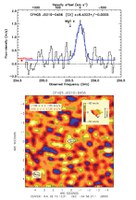 Willott et al. report ALMA Cycle 0 Early Science observations of rest-frame far-infrared continuum and [CII] line emission in two z = 6.4 quasars with black hole masses of ~ 108 M⊙. One galaxy is detected in dust and [CII] emission, and the other is not. The upper limits for J2329–0301 imply a star formation rate of < 40 M⊙ yr–1, considerably below the typical value at all redshifts given the quasar luminosity. Through comparison with hydro simulations, the authors speculate that this quasar is observed at a relatively rare phase where quasar feedback has effectively shut down star formation in the host galaxy. The [C II] line of J0210–0456 is narrow (FWHM = 189 km s–1), indicating a dynamical mass substantially lower than expected from the local black hole-velocity dispersion correlation. The [C II] line is resolved, with the blue and red wings spatially offset by 0.5 arcsec (3 kpc) and a smooth velocity gradient of 100 km s–1 across a scale of 6 kpc. These observations are consistent with the idea that stellar mass growth lags black hole accretion for quasars at this epoch with respect to more recent times.
Willott et al. report ALMA Cycle 0 Early Science observations of rest-frame far-infrared continuum and [CII] line emission in two z = 6.4 quasars with black hole masses of ~ 108 M⊙. One galaxy is detected in dust and [CII] emission, and the other is not. The upper limits for J2329–0301 imply a star formation rate of < 40 M⊙ yr–1, considerably below the typical value at all redshifts given the quasar luminosity. Through comparison with hydro simulations, the authors speculate that this quasar is observed at a relatively rare phase where quasar feedback has effectively shut down star formation in the host galaxy. The [C II] line of J0210–0456 is narrow (FWHM = 189 km s–1), indicating a dynamical mass substantially lower than expected from the local black hole-velocity dispersion correlation. The [C II] line is resolved, with the blue and red wings spatially offset by 0.5 arcsec (3 kpc) and a smooth velocity gradient of 100 km s–1 across a scale of 6 kpc. These observations are consistent with the idea that stellar mass growth lags black hole accretion for quasars at this epoch with respect to more recent times.
View Publication: Redshift 6.4 Host Galaxies of 108 Solar Mass Black Holes: Low Star Formation Rate and Dynamical Mass, Chris J. Willott (HIA), Alain Omont (Institut d’Astrophysique de Paris), & Jacqueline Bergeron (Institut d’Astrophysique de Paris), 2013 ApJ, 770, 13 (10 June 2013).
Imaging an Evaporating Protostellar Disk
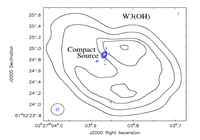 Dzib et al. analyze VLA observations at ~ 0.05 arcsec resolution, as well as archival VLA data, of the time-variable radio source projected near the center of the ultra-compact HII region W3(OH). The spectral index and the brightness temperature (~6,500 K) suggest partially optically thick free-free radiation, but an interpretation in terms of an ionized stellar wind fails because the detected flux densities are orders of magnitude larger than expected. The radio emission likely arises in a static ionized atmosphere around a fossil photoevaporated disk around a massive protostar.
Dzib et al. analyze VLA observations at ~ 0.05 arcsec resolution, as well as archival VLA data, of the time-variable radio source projected near the center of the ultra-compact HII region W3(OH). The spectral index and the brightness temperature (~6,500 K) suggest partially optically thick free-free radiation, but an interpretation in terms of an ionized stellar wind fails because the detected flux densities are orders of magnitude larger than expected. The radio emission likely arises in a static ionized atmosphere around a fossil photoevaporated disk around a massive protostar.
View Publication: The compact, time-variable radio source projected inside W3(OH): Evidence for photoevaporated disk?, Sergio Dzib(UNAM), Carolina B. Rodriguez-Garza (UNAM), Luis F. Rodrigeuz (UNAM, King Abdulaziz), Stan. E. Kurtz (UNAM), Laurent Loinard (UNAM), Luis A. Zapata (UNAM), & Susana Lizano (UNAM), 2013 ApJ, 772, 151 (1 August 2013).
A Dust Trap in a Transition Disk
Though the statistics of discovered exoplanets suggest that planets form efficiently, we still struggle to understand exactly how planets form. There remain fundamental unsolved problems, such as the excessive inward drift of particles in protoplanetary disks during planet formation. Recent planet formation theories invoke dust traps to overcome this problem. Marel et al. report in Science the detection of a dust trap in the disk around the star Oph IRS 48 using ALMA observations. Their λ ~ 0.44mm (685 GHz, ALMA Band 9) continuum map shows high-contrast crescent-shaped emission on one side of the star, originating from millimeter-sized grains, whereas both the mid-infrared image (micrometer-sized dust) and the gas traced by the CO 6-5 rotational line suggest rings centered on the star. The difference in distribution of large grains versus small grains/gas can be modeled with a vortex-shaped dust trap triggered by a companion.
View Publication: A Major Asymmetric Dust Trap in a Transition Disk, Nienke van der Marel (Leiden), Ewine F. van Dishoeck (Leiden, MPIfEP), Simon Bruderer (MPIfEP), Til Birnstiel (CfA), Paola Pinilla (Heidelberg), Cornelis P. Dullemond (Heidelberg), Tim A. van Kempen (Leiden, JAO), Markus Schmalzl (Leiden), Joanna M. Brown (CfA), Gregory J. Herczeg (Kavli Institute-Peking), Geoffrey S. Mathews (Leiden), Vincent Geers (Dublin Institute for Advanced Studies), 2013 Science, 340, 1199 (7 June 2013).
View 6 June 2013 Press Release
Rare Multiple Quasar Imaging Event Detected
The first detection of multiple imaging of an AGN jet due to refractive foreground scattering in our galaxy has been reported by Pushkarev et al. This rare phenomenon was first predicted several decades ago and is based on the refractive properties of AU-scale electron density enhancements in the ionized component of the Galactic interstellar medium. The predicted effect has now been seen in the low galactic latitude quasar 2023+335, one of a large sample of AGNs monitored by the MOJAVE VLBA Key Science Project. The strongest event showed a refractive image ~ 1/10th as bright as the primary image on 28 May 2009 at 15 GHz, when the source was undergoing an extreme scattering event. The VLBA image was taken serendipitously during a special phase when a caustic spike associated with the lens edge passed over the source. While the parsec-scale jet of the source normally extends along an angle of ‑20 degrees, a highly significant multi-component pattern of secondary images induced by strong refraction appears stretched out roughly along the constant galactic latitude line at an angle of +40 degrees. This suggests that the direction of relative motion of the lens is parallel to the galactic plane, as expected for an orbiting cloud.
View Publication: VLBA observations of a rare multiple quasar imaging event caused by refraction in the interstellar medium, A.B. Pushkarev (MPIfR, Pulkovo Obs, Crimean Obs), Y.Y. Kovalev (Lebedev, MPIfR), M.L. Lister (Purdue), T. Hovatta (Caltech), T. Savolainen (MPIfR), M.F. Aller (Michigan), H.D. Aller (Michigan), E. Ros (Valencia, MPIfR), J.A. Zensus (MPIfR), J.L. Richards (Purdue), W. Max-Moerbeck (Caltech), and A.C.S. Readhead (Caltech), 2013 A&A, 555, 80 (July 2013).
Accurate Distance Vindicates Disk Theory
Dwarf novae are white dwarfs accreting matter from a nearby red dwarf companion. Their regular outbursts are explained by a thermal-viscous instability in the accretion disk, which is described by the disk instability model that has since been extended to other accreting astronomical systems. However, the prototypical dwarf nova, SS Cygni, has presented a major challenge to accretion disk theory. At the distance of 159 ± 12 parsecs measured by the Hubble Space Telescope, SS Cygni is too luminous to be undergoing the regular observed outbursts. Using very long baseline interferometric radio observations acquired with the VLBA and the European VLBI Network, Miller-Jones et al. report an accurate, model-independent distance to SS Cygni of 114 ± 2 parsecs. This new distance reconciles the behavior of SS Cygni with our understanding of accretion disk theory.
View Publication: An Accurate Geometric Distance to the Compact Binary SS Cygnii Vindicates Accretion Disk Theory, J.C.A. Miller-Jones (Curtin), G.R. Sivakoff (Alberta, Virginia),C. Knigge (Southampton), E.G. Körding (Radboud), M. Templeton (AAVSO), E.O. Waggen (AAVSO), 2013 Science, 340, 950 (24 May 2013).
View 23 May 2013 Press Release
Observing Intergalactic HI
 Spiral galaxies must acquire gas to maintain their observed level of star formation beyond the next few billion years. The gas that resides between galaxies may be the source for this material, but our understanding of the state and distribution of this gas is incomplete. Radio observations of the Local Group of galaxies have revealed hydrogen gas extending from the galactic disk of M31 at least halfway to M33. This feature has been interpreted to be the neutral component of a condensing intergalactic filament that would be able to fuel star formation in M31 and M33. Simulations suggest, however, that such a feature could also result from an interaction between both galaxies within the past few billion years. In this Nature paper, Wolfe et al. report GBT observations showing that about 50% of the diffuse gas between M31 and M33 is composed of clouds; the remainder is distributed in an extended, diffuse component. These clouds have velocities comparable to those of M31 and M33, and have properties suggesting they are unrelated to other Local Group objects. These GBT observations strongly support the idea of gas accretion from the inter-galactic medium along filamentary structures as the fuel for future star formation in M31 and M33.
Spiral galaxies must acquire gas to maintain their observed level of star formation beyond the next few billion years. The gas that resides between galaxies may be the source for this material, but our understanding of the state and distribution of this gas is incomplete. Radio observations of the Local Group of galaxies have revealed hydrogen gas extending from the galactic disk of M31 at least halfway to M33. This feature has been interpreted to be the neutral component of a condensing intergalactic filament that would be able to fuel star formation in M31 and M33. Simulations suggest, however, that such a feature could also result from an interaction between both galaxies within the past few billion years. In this Nature paper, Wolfe et al. report GBT observations showing that about 50% of the diffuse gas between M31 and M33 is composed of clouds; the remainder is distributed in an extended, diffuse component. These clouds have velocities comparable to those of M31 and M33, and have properties suggesting they are unrelated to other Local Group objects. These GBT observations strongly support the idea of gas accretion from the inter-galactic medium along filamentary structures as the fuel for future star formation in M31 and M33.
View Publication: Discrete Gas Clouds of Neutral Gas between the Galaxies M31 and M33, Spenser A. Wolfe (WVU), D.J. Paisano (WVU, NRAO), Felix J. Lockman (NRAO), Stacy S. McGaugh (Case Western), and Edward J. Shaya (Maryland), 2013 Nature, 497, 224 (9 May 2013).
Einstein Passes Toughest Test Yet
Many physically motivated extensions to general relativity (GR) predict substantial deviations in the properties of spacetime surrounding massive neutron stars. Antoniadis et al. report in Science their measurement with the GBT of a 2.01 ± 0.04 solar mass (M⊙) pulsar in a 2.46-hour orbit with a 0.172 ± 0.003 M⊙ white dwarf. The high pulsar mass and the compact orbit make this system a sensitive laboratory of a previously untested strong-field gravity regime. Thus far, the observed orbital decay agrees with GR, supporting its validity even for the extreme conditions present in the system. The resulting constraints on deviations support the use of GR-based templates for ground-based gravitational wave detectors. Additionally, the system strengthens recent constraints on the properties of dense matter and provides insight to binary stellar astrophysics and pulsar recycling.
View Publication: A Massive Pulsar in a Compact Relativistic Binary, John Antoniadis (MPIfR), Paulo C. C. Freire (MPIfR), Norbert Wex (MPIfR), Thomas M. Tauris (Argelander, MPIfR), Ryan S. Lynch (McGill), Marten H. van Kerkwijk (Toronto), Michael Kramer (MPIfR, Jodrell Bank), Cees Bassa (Jodrell Bank), Vik S. Dhillon (Sheffield), Thomas Driebe (DLR), Jason W. T. Hessels (ASTRON, Amsterdam), Victoria M. Kaspi (McGill), Vladislav I. Kondratiev (ASTRON, Lebedev), Norbert Langer (Argelander), Thomas R. Marsh (Warwick), Maura A. McLaughlin (WVU), Timothy T. Pennucci (Virginia), Scott M. Ransom (NRAO), Ingrid H. Stairs (UBC), Joeri van Leeuwen (ASTRON), Joris P. W. Verbiest (ASTRON, Amsterdam), David G. Whelan (Virginia), 2013 Science, 340, 397 (26 April 2013).
View 25 April 2013 Press Release
The Earliest Extreme Starburst
Massive present-day early-type galaxies likely gained the bulk of their stellar mass and heavy elements through intense, dust-enshrouded starbursts in the most massive dark-matter haloes at early epochs. However, it has been unknown how soon after the Big Bang massive starburst progenitors exist. Now, using a submillimeter color-selection technique, Reichers et al have identified and unambiguously determined the redshift to the earliest (z = 6.34) extreme starburst galaxy via observations of multiple molecular and atomic fine-structure lines with CARMA, the Plateau de Bure Interferometer, the VLA, and CSO. This system represents the formation of a massive galaxy in an extreme starburst within 880 Myr of the Big Bang. These results demonstrate the power of centimeter through sub-millimeter spectroscopy to study the interstellar medium in the earliest galaxies, and determine redshifts for the earliest, highly dust-obscured galaxies.
View Publication: A Dust Obscured Massive Maximum-Starburst Galaxy at Redshift 6.3, Dominik A. Riechers (Cornell), C. M. Bradford (Caltech), D. L. Clements (Imperial College), C. D. Dowell (JPL), I. Pérez-Fournon (Universidad de La Laguna), R. J. Ivison (UK ATC, Edinburgh), C. Bridge (Caltech), A. Conley (Colorado-Boulder), Hai Fu (UC-Irvine), J. D. Vieira (Caltech), J. Wardlow (UC-Irvine), J. Calanog (UC-Irvine), A. Cooray (UC-Irvine), P. Hurley (Sussex), R. Neri (IRAM), J. Kamenetzky (Colorado-Boulder), J. E. Aguirre (Pennsylvania), B. Altieri (Herschel Science Centre), V. Arumugam (Edinburgh), D. J. Benford (NASA-Goddard), M. Béthermin (CNRS), J. Bock (Caltech, JPL), D. Burgarella (CNRS), A. Cabrera-Lavers (Centro de Astrofísica de La Palma), S. C. Chapman (Cambridge) et al., 2013 Nature, 496, 329 (18 April 2013).
View 17 April 2013 Press Release
Imaging Protostellar Outflows
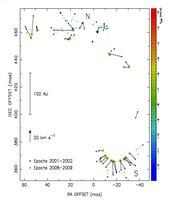 The VLBA has imaged water maser emission from a massive star-forming region (AFLG 2591) in unprecedented detail, revealing persistent bow shock structures that indicate outflows on 300 AU-scales. The measured proper motions imply bow shock expansion at 20 km/s, possibly driven by two different massive protostars, or two outflows from a single star.
The VLBA has imaged water maser emission from a massive star-forming region (AFLG 2591) in unprecedented detail, revealing persistent bow shock structures that indicate outflows on 300 AU-scales. The measured proper motions imply bow shock expansion at 20 km/s, possibly driven by two different massive protostars, or two outflows from a single star.
View Publication: Formation and Evolution of the water maser outflow event in AFGL 2591 VLA 3-N, M.A. Trinidad (Guanajuato), S. Curiel (UNAM), R. Estalella (Barcelona), J. Canto (UNAM), A. Raga (UNAM), J.M. Torrelles (Barcelona), N.A. Patel (CfA), J.F. Gomez (CSIC), G. Anglada (CSIC), C. Carrasco-Gonzalez (MPIfR), and L.F. Rodriguez (UNAM), 2013 MNRAS, 430, 1309 (1 April 2013).
Dusty Starburst Galaxies in the Early Universe

Our understanding of galaxy evolution has been revolutionized by the discovery that luminous, dusty starburst galaxies were much more abundant in the early Universe than now. It has, however, been difficult to measure their complete redshift distribution, especially at the highest redshifts (z > 4). Vieira (Caltech) et al report on a redshift survey at λ = 3mm, targeting carbon monoxide line emission from the star-forming molecular gas in the direction of extremely bright mm-selected sources. High-resolution ALMA imaging demonstrates that these sources are strongly gravitationally lensed by foreground galaxies. The authors detect spectral lines in 23 of 26 sources and multiple lines in 12 of these 23 sources, obtaining robust redshifts. At least 10 of the sources are at z > 4, indicating that the fraction of dusty starburst galaxies at high redshifts is greater than previously thought. Models of lens geometries in the sample indicate that the background objects are ultra-luminous infrared galaxies, powered by extreme bursts of star formation.
View Publication: Dusty Starburst Galaxies in the Early Universe as Revealed by Gravitational Lensing, J. D. Vieira (Caltech), D. P. Marrone (Arizona), S. C. Chapman (Dalhousie, Cambridge), C. De Breuck (ESO), Y. D. Hezaveh (McGill), A. Weiβ (MPIfR), J. E. Aguirre (Pennsylvania), K. A. Aird (Chicago), M. Aravena (ESO), M. L. N. Ashby (CfA), M. Bayliss (Harvard), B. A. Benson (Chicago), A. D. Biggs (ESO), L. E. Bleem (Chicago), J. J. Bock (Caltech, JPL), M. Bothwell (Arizona), C. M. Bradford (JPL), M. Brodwin (Missouri), J. Carlstrom (Chicago), C. L. Chang (Chicago, Argonne), T. M. Crawford (Chicago), A. T. Crites (Chicago), T. de Haan (McGill), M. A. Dobbs (McGill), E. B. Fomalont (NRAO) et al., 2013 Nature, 495, 344 (21 March 2013).
View 13 March 2013 Press Release
The Detection of Interstellar Ethanimine
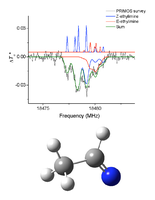 Ethanime is one of the large interstellar “imines” ever detected. These molecules are important in the formation of larger organic species like amino acids, and finding amino acid precursors is a step closer to understanding our molecular origins in the Universe. The detection of ethanimine is significant because of its possible role in the formation of alanine—one of the twenty amino acids in the genetic code. Observations acquired by Loomis et al for the GBT Prebiotic Interstellar Molecule Survey (PRIMOS) toward the Sagittarius B2 North (SgrB2N) region detected 2 structural isomers of ethanimine (CH3CH=NH). Shown in the spectrum (below) are the GBT data (black) and a model of the 2 ethanimine isomers (blue and red).
Ethanime is one of the large interstellar “imines” ever detected. These molecules are important in the formation of larger organic species like amino acids, and finding amino acid precursors is a step closer to understanding our molecular origins in the Universe. The detection of ethanimine is significant because of its possible role in the formation of alanine—one of the twenty amino acids in the genetic code. Observations acquired by Loomis et al for the GBT Prebiotic Interstellar Molecule Survey (PRIMOS) toward the Sagittarius B2 North (SgrB2N) region detected 2 structural isomers of ethanimine (CH3CH=NH). Shown in the spectrum (below) are the GBT data (black) and a model of the 2 ethanimine isomers (blue and red).
View Publication: The Detection of Interstellar Ethanimine (CH3CHNH) from Observations Taken during the GBT PRIMOS Survey, Ryan A. Loomis, Daniel P. Zaleski, Amanda L. Steber, Justin L. Neill, Matthew T. Muckle, Brent J. Harris (Virginia); Jan M. Hollis (NASA-Goddard); Phillip R. Jewell (NRAO); Valerio Lattanzi (CfA, Harvard); Frank J. Lovas (NIST); Oscar Martinez, Michael C. McCarthy (CfA, Harvard); Anthony J. Remijan (NRAO); Brooks H. Pate and Joanna F. Corby (Virginia), 2013 ApJ Letters, 765, L9 (1 March 2013).
ALMA Observations of the Redshift 4.7 Quasar System BRI 1202-0725
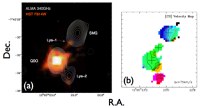 The authors provide an in-depth analysis of the ALMA science verification observations of BRI 1202-0725. This z = 4.7 system consists of a hyperluminous infrared quasar host and an optically obscured submillimeter galaxy (SMG). In addition, two Lyα selected galaxies (Lyα-1 and Lyα-2 in Figure) lie in close proximity to the quasar host and SMG. As can also be seen in the [C II] 158 μm velocity map, the Lyα galaxies are detected along with the quasar host and SMG, showing the strength of Early Science ALMA – in this case, with just 17 antennas – to detect this major cooling line even from high redshift UV-selected galaxies. The Lyα galaxies are estimated to have star formation rates of 19 - 170 solar masses per year based on a combination of their [CII] and FIR luminosities. These rates are an order of magnitude or more less than that of the quasar host and the SMG. The authors also detect a broad [C II] emission line wing associated with the quasar host and attribute it to gas outflowing from the host at 80 solar masses per year. At such a rate, the available supply of molecular gas would be swept out of the host in ~ 6x108 years. This time scale is, however, a factor of at least 10 longer than the star formation consumption timescale estimated under the assumption that all of the far-infrared emission from the host is due to star formation.
The authors provide an in-depth analysis of the ALMA science verification observations of BRI 1202-0725. This z = 4.7 system consists of a hyperluminous infrared quasar host and an optically obscured submillimeter galaxy (SMG). In addition, two Lyα selected galaxies (Lyα-1 and Lyα-2 in Figure) lie in close proximity to the quasar host and SMG. As can also be seen in the [C II] 158 μm velocity map, the Lyα galaxies are detected along with the quasar host and SMG, showing the strength of Early Science ALMA – in this case, with just 17 antennas – to detect this major cooling line even from high redshift UV-selected galaxies. The Lyα galaxies are estimated to have star formation rates of 19 - 170 solar masses per year based on a combination of their [CII] and FIR luminosities. These rates are an order of magnitude or more less than that of the quasar host and the SMG. The authors also detect a broad [C II] emission line wing associated with the quasar host and attribute it to gas outflowing from the host at 80 solar masses per year. At such a rate, the available supply of molecular gas would be swept out of the host in ~ 6x108 years. This time scale is, however, a factor of at least 10 longer than the star formation consumption timescale estimated under the assumption that all of the far-infrared emission from the host is due to star formation.
View Publication: The Anatomy of an Extreme Starburst Within 1.3 Gyr of the Big Bang Revealed by ALMA, C.L. Carilli (NRAO, Cavendish), D. Riechers (Caltech), F. Walter (MPIfA), R. Maiolino (Cavendish), J. Wagg (ESO), L. Lentati (Cavendish), R. McMahon (Cambridge), and A. Wolfe (UCSD), 2013 ApJ, 763, 120 (1 February 2013).
Measuring the Cosmic HI Mass Density
Masui et al. present GBT HI intensity mapping in the range 0.6 < z < 1, over two fields totaling ∼ 41 sq deg in the WiggleZ Dark Energy Survey area. These images represent the integrated HI surface brightness of thousands of galaxies over large cosmic volumes. The cross-correlation with the smoothed optical spectroscopic data shows a clear correlation, indicating HI signal on deg-scales. The HI intensity is consistent with optical quasar absorption line measurements for the evolution of the cosmic HI mass density.
View Publication: Measurement of 21cm Brightness Fluctuations at z~0.8 in Cross Correlation, K. W. Masui (CITA), E. R. Switzer (CITA, Chicago), N. Banavar (Toronto), K. Bandura (McGill), C. Blake (Swinburne), L.-M. Calini (CITA), T.-C. Chang (ASIAA), X. Chen (National Astronomical Observatories, Chinese Academy of Science; Peking), Y.-C. Li (National Astronomical Observatories, Chinese Academy of Science), Y.-W. Liao (ASIAA), A. Natarajan (Carnegie Mellon), U.-L. Pen (CITA), J. B. Peterson (Carnegie Mellon), J. R. Shaw (CITA), T. C. Voytek (Carnegie Mellon), 2013 ApJ Letters, 763, L20 (20 January 2013).
Added 13 Feb 2013
Imaging Magnetic Reconnection on the Sun
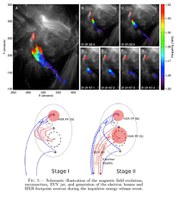 Type III radio bursts from the Sun correspond to thermal electron beams propagating in the low corona. The VLA has imaged these bursts on times scales ~100 ms. The beams emanate from an energy release site located in the low corona and propagate along a bundle of discrete magnetic loops upward into the corona. The diameter of these loops is less than 100 km. These over-dense and ultra-thin loops reveal the fibrous structure of the Sun’s corona. The localized energy release is highly fragmentary in time and space, supporting a bursty reconnection model that involves secondary magnetic structures for magnetic energy release and particle acceleration.
Type III radio bursts from the Sun correspond to thermal electron beams propagating in the low corona. The VLA has imaged these bursts on times scales ~100 ms. The beams emanate from an energy release site located in the low corona and propagate along a bundle of discrete magnetic loops upward into the corona. The diameter of these loops is less than 100 km. These over-dense and ultra-thin loops reveal the fibrous structure of the Sun’s corona. The localized energy release is highly fragmentary in time and space, supporting a bursty reconnection model that involves secondary magnetic structures for magnetic energy release and particle acceleration.
View Publication: Tracing Electron Beams in the Sun's Corona with Radio Dynamic Imaging Spectroscopy, Bin Chen (Virginia), T.S. Bastian (NRAO), S.M. Shite (Air Force Research Lab), D.E. Gary (New Jersey Institute of Technology), R. Perley (NRAO), M. Rupen (NRAO), and B. Carlson (NRC-Canada), 2013 ApJ Letters, 763, L21 (20 January 2013).
Imaging an Extragalactic Microquasar
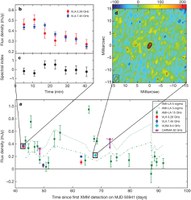 Microquasars in the Milky Way are likely relativistic jets driven by accretion on to 5 to 20 M⊙ black holes, with the jet launched within a few Rs of the black hole. Middleton et al. have discovered a variable X-ray source in M31 with Lx up to 1040 erg/s, corresponding to a microquasar. The radio luminosity is extremely high and shows variability on a timescale of tens of minutes, arguing that the source is highly compact and powered by accretion close to the Eddington limit onto a black hole of a few stellar masses. The VLBA data imply a source size of less than 1milli-arcsec ~ 1016 cm.
Microquasars in the Milky Way are likely relativistic jets driven by accretion on to 5 to 20 M⊙ black holes, with the jet launched within a few Rs of the black hole. Middleton et al. have discovered a variable X-ray source in M31 with Lx up to 1040 erg/s, corresponding to a microquasar. The radio luminosity is extremely high and shows variability on a timescale of tens of minutes, arguing that the source is highly compact and powered by accretion close to the Eddington limit onto a black hole of a few stellar masses. The VLBA data imply a source size of less than 1milli-arcsec ~ 1016 cm.
Figure: Radio light curves of the microquasar in M31 from the Arcminute Microkelvin Imager (AMI), VLA, VLBA, others. The VLBA image shown implies a source size of less than a milli-arcsecond.
View Publication: Bright Radio Emission from an Ultraluminous Stellar-mass Microquasar in M31,
Matthew J. Middleton (Durham) et al., 2013 Nature, 493, 187 (10 January 2013).
NANOGrav Pulsar Timing Gravitational Wave Detection Limit
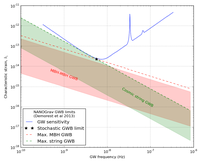 Demorest et al report their analysis of high-precision pulsar timing data acquired via the North American Nanohertz Observatory for Gravitational Waves (NANOGrav) project. Seventeen pulsars have been observed over about five years using the GBT and the Arecibo Observatory. These data were analyzed using standard pulsar timing models, with the addition of time-variable dispersion measure and frequency-variable pulse shape terms. Sub-microsecond timing residuals are obtained in nearly all cases, and the best rms timing residuals are ~30-50 ns. The authors present methods for analyzing post-fit timing residuals for the presence of a gravitational wave signal with a specified spectral shape. These optimally take into account the timing fluctuation power removed by the model fit, and can be applied to either data from a single pulsar, or to a set of pulsars to detect a correlated signal. These data and methods yield the best upper limit to date on the strength of the nHz-frequency stochastic supermassive black hole gravitational wave background of hc (1 yr–1) < 7 × 10–15 (95%).
Demorest et al report their analysis of high-precision pulsar timing data acquired via the North American Nanohertz Observatory for Gravitational Waves (NANOGrav) project. Seventeen pulsars have been observed over about five years using the GBT and the Arecibo Observatory. These data were analyzed using standard pulsar timing models, with the addition of time-variable dispersion measure and frequency-variable pulse shape terms. Sub-microsecond timing residuals are obtained in nearly all cases, and the best rms timing residuals are ~30-50 ns. The authors present methods for analyzing post-fit timing residuals for the presence of a gravitational wave signal with a specified spectral shape. These optimally take into account the timing fluctuation power removed by the model fit, and can be applied to either data from a single pulsar, or to a set of pulsars to detect a correlated signal. These data and methods yield the best upper limit to date on the strength of the nHz-frequency stochastic supermassive black hole gravitational wave background of hc (1 yr–1) < 7 × 10–15 (95%).
View Publication: Limits on the Stochastic Gravitational Wave Background from the North American Nanohertz Observatory for Gravitational Waves, P. B. Demorest (NRAO), R. D. Ferdman (McGill), M. E. Gonzalez (UBC), D. Nice (Lafayette), S. Ransom (NRAO), I. H. Stairs (UBC), Z. Arzoumanian (NASA-Goddard, USRA), A. Brazier (Cornell), S. Burke-Spolaor (NASA-JPL), S. J. Chamberlin (Wisconsin-Milwaukee), J. M. Cordes (Cornell), J. Ellis (Wisconsin-Milwaukee), L. S. Finn (Pennsylvania State Univ), P. Freire (MPIfR), S. Giampanis (Wisconsin-Milwaukee), F. Jenet (UT-Brownsville), V. M. Kaspi (McGill), J. Lazio (NASA-JPL), A. N. Lommen (Franklin & Marshall), M. McLaughlin (West Virginia), N. Palliyaguru (West Virginia), D. Perrodin (Franklin & Marshall), R. M. Shannon (CSIRO), X. Siemens (Wisconsin-Milwaukee), D. Stinebring (Oberlin), J. Swiggum(West Virginia), and W. W. Zhu (UBC), 2013 ApJ, 762, 94 (10 January 2013).
Gas Flows through a Protoplanetary Gap
Previous infrared observations of the protoplanetary disk around the young and relatively nearby star HD142527 found an inner disk about 10 AU in radius, surrounded by a large gap and a disrupted outer disk at 140+ AU. This disruption indicates an unseen planetary mass at ~90 AU. Cassasus et al have used the excellent sensitivity and spatial resolution of ALMA to image dense gas in gap-crossing filaments, along with diffuse CO within the gap. These ALMA data explain how the observed high accretion rate – 7 × 10−9 to 2 × 10−7 solar masses/year – may be maintained, and support dynamical models that suggest the outer disk gas could be channeled by putative protoplanets through gap-crossing bridges feeding the inner disk.
|
This 3-dimensional view of the HD142527 ALMA Band 7 dataset illustrates the emission distribution on the sky and in velocity-frequency space (vertical axis), enabling detailed study of the gas filament dynamics for this interesting planet-forming system. Data visualizations such as these provide astronomers new tools to explore the phase space of their results and mine their data.
Visualization and video courtesy Brian Kent. This video requires JavaScript to be enabled and the latest Adobe Flash Player version. |
View Publication: Flows of Gas through a Protoplanetary Gap, Simon Casassus (Univ Chile), Gerrit van der Plas (Univ Chile), Sebastian Perez M. (Univ Chile), William R. F. Dent (JAO, ESO), Ed Fomalont (NRAO), Janis Hagelberg (Chemin des Maillettes), Antonio Hales (JAO, NRAO), Andres Jordan (Univ Catolica de Chile), Dimitri Mawet (ESO), Francois Menard (CNRS, Univ Chile), Al Wootten (NRAO), David Wilner (CfA), A. Meredith Hughes (UC Berkeley), Matthias R. Schreiber (Univ Valparaiso), Julien H. Girard (ESO), Barbara Ercolano (Ludwig-Maximillians Univ), Hector Canovas (Univ Valparaiso), Pablo E. Roman (Univ Chile), and Vachail Salinas Univ Chile), 2013 Nature, 493, 191 (10 January 2013).
A Young Solar System Analog Disk
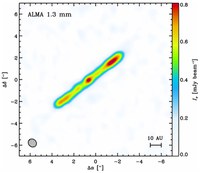 MacGregor et al present 1.3mm ALMA Cycle 0 Early Science observations of the edge-on debris disk around the relatively nearby M1 star AU Mic. These data reveal two distinct debris emission components: (1) the previously known dust belt that extends to a radius of 40 AU, and (2) a newly recognized, unresolved central peak. The central peak is ∼6X brighter than the stellar photosphere. The authors suggest this peak may be dominated by dust emission from an inner planetesimal belt, which is consistent with a lack of emission at λ < 25 μm and a location < 3 AU from the star. The cold, outer dust belt appears truncated, reminiscent of a classic Kuiper Belt. The origins of the sharp edge could be from dynamical interactions or may simply represent the initial conditions. These ALMA data show no evidence for asymmetries or substructure that would indicate planet-disk interactions, though the measurement limit of the centroid offset between the outer belt and central peak is still compatible with the presence of a Uranus-like planet.
MacGregor et al present 1.3mm ALMA Cycle 0 Early Science observations of the edge-on debris disk around the relatively nearby M1 star AU Mic. These data reveal two distinct debris emission components: (1) the previously known dust belt that extends to a radius of 40 AU, and (2) a newly recognized, unresolved central peak. The central peak is ∼6X brighter than the stellar photosphere. The authors suggest this peak may be dominated by dust emission from an inner planetesimal belt, which is consistent with a lack of emission at λ < 25 μm and a location < 3 AU from the star. The cold, outer dust belt appears truncated, reminiscent of a classic Kuiper Belt. The origins of the sharp edge could be from dynamical interactions or may simply represent the initial conditions. These ALMA data show no evidence for asymmetries or substructure that would indicate planet-disk interactions, though the measurement limit of the centroid offset between the outer belt and central peak is still compatible with the presence of a Uranus-like planet.
View Publication: Millimeter Emission Structure in the First ALMA Image of the AU Mic Debris Disk, Meredith A. MacGregor (CfA), David J. Wilner (CfA), Katherine A. Rosenfeld (CfA), Sean M. Andrews (CfA), Brenda Matthews (HIA), A. Meredith Hughes (UC Berkeley), Mark Booth (HIA, Univ Victoria), Eugene Chiang (UC Berkeley), James R. Graham (UC Berkeley, Univ Toronto), Paul Kalas (UC Berkeley, SETI), Grant Kennedy (Cambridge), and Bruce Sibthorpe (SRON), 2013 ApJ Letters, 762, L21 (10 January 2013).
Interacting Cosmic Rays with Molecular Clouds
Diffuse γ-ray emission (1-300 Gev) from the Galactic Center has been difficult to explain. A NRAO GBT 1.4 GHz synchrotron image compared with the Fermi Gamma-ray Space Telescope image shows clear correlation, indicating that the γ-rays are produced by thermal bremstrahlung due to interaction of the synchrotron emitting relativistic electrons with the thermal gas.
View Publication: Interacting Cosmic Rays with Molecular Clouds: A Bremsstrahlung Origin of Diffuse High Energy Emission from the Inner 2deg by 1deg of the Galactic Center, Yusef-Zadeh, F. (Northwestern), Hewitt, J.W. (NASA-Goddard), Wardle, M. (Macquarie), Tatischeff, V. (Paris-Sud), Roberts, D. (Northwestern), Cotton, W. (NRAO), Uchiyama, H. (Kyoto), Nobukawa, M. (Kyoto), Tsuru, T.G. (Kyoto), Heinke, C. (Alberta), & Royster, M. (Northwestern), 2013 ApJ, 762, 33 (1 January 2013)
Added 13 Feb 2013
Grain Growth and Molecular Gas in the Disk around a Young Brown Dwarf
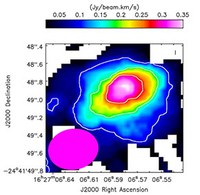 ALMA continuum and spectral line observations (λ ~ 0.89 and 3.2 micron) are used to analyze the young brown dwarf system ρ-Oph 102. Dust emission is detected from the disk and an upper limit of ~ 40 AU is derived for the radius of the dusty disk. The derived variation of the dust opacity with frequency provides evidence for mm-sized grains in the disk's outer regions, demonstrating that such grains are found even in the low-density environments of brown dwarf disks and challenging our understanding of dust evolution in disks. The CO map at 345 GHz clearly reveals molecular gas emission at the brown dwarf’s location, indicating a gas-rich disk as typically found for disks surrounding young pre-main-sequence stars. We derive a disk mass of ~ 0.3 - 1% of the mass of the central brown dwarf, similar to the typical values found for disks around more massive young stars.
ALMA continuum and spectral line observations (λ ~ 0.89 and 3.2 micron) are used to analyze the young brown dwarf system ρ-Oph 102. Dust emission is detected from the disk and an upper limit of ~ 40 AU is derived for the radius of the dusty disk. The derived variation of the dust opacity with frequency provides evidence for mm-sized grains in the disk's outer regions, demonstrating that such grains are found even in the low-density environments of brown dwarf disks and challenging our understanding of dust evolution in disks. The CO map at 345 GHz clearly reveals molecular gas emission at the brown dwarf’s location, indicating a gas-rich disk as typically found for disks surrounding young pre-main-sequence stars. We derive a disk mass of ~ 0.3 - 1% of the mass of the central brown dwarf, similar to the typical values found for disks around more massive young stars.
View Publication: ALMA Observations of ρ-Oph 102: Grain Growth and Molecular Gas in the Disk around a Young Brown Dwarf, L. Ricci (Caltech), L. Testi (ESO, INAF), A. Natta (INAF, Dublin Institute), A. Scholz (Dublin Institute), and I. de Gregorio-Monsalvo (JAO), 2012 ApJ Letters, 761, L20 (20 December 2012).
HI Imaging of the M101 Group
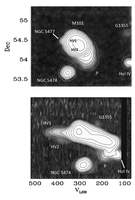 Imaging of M101 with the GBT has revealed an HI tidal plume that stretched 100 kpc with a mass of 108 M⊙. The plume rotates with the main body of M101, but also shows kinematic peculiarities suggestive of a warp or ring out of the rotation plane of the galaxy. Mihos et al have also detected two new HI clouds near the plume with masses ~107 M⊙, similar to HI clouds seen in the M81/M82 group, with no optical counterparts. The kinematically complex HI structure in the M101 group suggests that the group is in a dynamically active state that is likely common for galaxies in group environments.
Imaging of M101 with the GBT has revealed an HI tidal plume that stretched 100 kpc with a mass of 108 M⊙. The plume rotates with the main body of M101, but also shows kinematic peculiarities suggestive of a warp or ring out of the rotation plane of the galaxy. Mihos et al have also detected two new HI clouds near the plume with masses ~107 M⊙, similar to HI clouds seen in the M81/M82 group, with no optical counterparts. The kinematically complex HI structure in the M101 group suggests that the group is in a dynamically active state that is likely common for galaxies in group environments.
View Publication: The HI Environment of the M101 Group, J. Christopher Mihos (Case Western), Katie M. Keating (Rincon Research Corp), Kelly Holley-Bockelmann (Vanderbilt, Fisk), D.J.Pisano (West Virginia, NRAO), and Namir Kassim (Naval Research Lab), 2012 ApJ, 761, 186 (20 December 2012).
Serendipitous High z [C II] 158 μm Detection
![ALMA: Serendipitous High z [C II] 158 μm Detection ALMA: Serendipitous High z [C II] 158 μm Detection](https://science.nrao.edu/science/highlights/images/fy2013/alma-serendipitous-high-z-c-ii-158-mm-detection/@@images/8d15c9d9-23c1-4a0e-ae41-e514d551dc19.jpeg) Swinbank et al present ALMA 870μm (345 GHz) observations of 2 submillimeter galaxies (SMGs) drawn from an ALMA study of the 126 SMGs in the LABOCA Extended Chandra Deep Field-South Survey. These ALMA data identify the counterparts to these previously unidentified submm sources and serendipitously detect bright emission lines that are most likely [CII] 158 μm emission, yielding redshifts z = 4.42 and 4.44. The volume probed by this ALMA survey demonstrates that the bright end of the [CII] luminosity function evolves strongly between z = 0 and ~ 4.4, reflecting the increased interstellar medium cooling in galaxies as a result of their higher star formation rates. Even with short integrations, ALMA is able to detect the dominant fine-structure cooling lines from high z ULIRGs, measure their energetics, spatially resolve key properties, and trace their evolution with redshift.
Swinbank et al present ALMA 870μm (345 GHz) observations of 2 submillimeter galaxies (SMGs) drawn from an ALMA study of the 126 SMGs in the LABOCA Extended Chandra Deep Field-South Survey. These ALMA data identify the counterparts to these previously unidentified submm sources and serendipitously detect bright emission lines that are most likely [CII] 158 μm emission, yielding redshifts z = 4.42 and 4.44. The volume probed by this ALMA survey demonstrates that the bright end of the [CII] luminosity function evolves strongly between z = 0 and ~ 4.4, reflecting the increased interstellar medium cooling in galaxies as a result of their higher star formation rates. Even with short integrations, ALMA is able to detect the dominant fine-structure cooling lines from high z ULIRGs, measure their energetics, spatially resolve key properties, and trace their evolution with redshift.
View Publication: An ALMA Survey of Submillimetre Galaxies in the Extended Chandra Deep Field-South: Detection of [CII] at z=4.4, A. M. Swinbank (Durham), A. Karim (Durham), Ian Smail (Durham), J. Hodge (MPIfA), F. Walter (MPIfA), F. Bertoldi (Bonn), A. D. Biggs (ESO), C. de Breuck (ESO), S. C. Chapman (Cambridge), K. E. K. Coppin (McGill), P. Cox (IRAM), A. L. R. Danielson (Durham), H. Dannerbauer (Wien), R. J. Ivison (UKATC, Edinburgh), T. R. Greve Univ College London), K. K. Knudsen (Chalmers), K. M. Menten (MPIfR), J. M. Simpson (Durham), E. Schinnerer (MPIfA), J. L. Wardlow (UC – Irvine), A. Weiß (MPIfR), and P. van der Werf (Leiden), 2012 MNRAS, 427, 1066 (1 December 2012).
Imaging Gas Clumps in Early Galaxies
 The VLA has imaged the molecular disk of a galaxy within 1.6 Gyr of the Big Bang at ~ 1 kpc resolution in the hyper-starburst galaxy GN20 (z = 4.0). These observations reveal a rotating disk of molecular gas on a scale of 14 kpc, with a dynamical mass ~ 5x1011 M⊙. The disk is comprised of massive molecular clumps, possibly self-gravitating. The gas distribution and dynamics is consistent with a disk formed via cold mode accretion from the IGM driving the extreme starburst.
The VLA has imaged the molecular disk of a galaxy within 1.6 Gyr of the Big Bang at ~ 1 kpc resolution in the hyper-starburst galaxy GN20 (z = 4.0). These observations reveal a rotating disk of molecular gas on a scale of 14 kpc, with a dynamical mass ~ 5x1011 M⊙. The disk is comprised of massive molecular clumps, possibly self-gravitating. The gas distribution and dynamics is consistent with a disk formed via cold mode accretion from the IGM driving the extreme starburst.
View Publication: Evidence for a Clumpy, Rotating Gas Disk in a Submillimeter Galaxy at z=4, J.A. Hodge (MPIfA), C.L. Carilli (NRAO, Cavenish Lab), F. Walter (MPIfA, NRAO), W.J.G. de Blok (ASTRON, Cape Town), D. Riechers (Caltech), E. Daddi (CEA), and L. Lentati (Cavendish), 2012 ApJ, 760, 11 (20 November 2012).
Imaging the Magellanic Stream
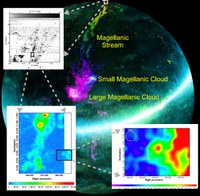 The Magellanic Stream is a nearby laboratory for studying the fate of cool gas stream injected into a gaseous galactic halo. Neutral hydrogen (HI) observations of the Magellanic Stream with the GBT have revealed a gas cloud interacting with the halo of the Milky Way. Absorption measurements toward a background source indicate a temperature of 8000K. Dynamical models indicate this cloud should eventually intercept the Milky Way disk.
The Magellanic Stream is a nearby laboratory for studying the fate of cool gas stream injected into a gaseous galactic halo. Neutral hydrogen (HI) observations of the Magellanic Stream with the GBT have revealed a gas cloud interacting with the halo of the Milky Way. Absorption measurements toward a background source indicate a temperature of 8000K. Dynamical models indicate this cloud should eventually intercept the Milky Way disk.
View Publication: Probing the Structure and Kinematics of the Transition Layer between the Magellanic Stream and the Halo in HI, Lou Nigra (Wisconsin, Adler), Snezana Stanimirovic (Wisconsin), John S. Gallagher (Wisconsin), Kenneth Wood (St. Andrews, Wisconsin), David Nidever (Virginia), and Steven Majewski (Virginia), 2012 ApJ, 760, 48 (20 November 2012).
Radio Dark Clouds in the Inner Galaxy
 GBT continuum images at 8 GHz show features that coincide with dense molecular clouds. These “radio dark clouds” are produced by a deficiency in radio continuum emission from molecular clouds that are embedded in a bath of UV radiation or synchrotron emitting cosmic-ray particles. The contribution of the continuum emission along different path lengths results in dark features that trace embedded molecular clouds. The new technique of identifying cold clouds constrains the depth and the magnetic field of molecular clouds, and their interaction with the hot thermal and non-thermal gas in the inner Galaxy.
GBT continuum images at 8 GHz show features that coincide with dense molecular clouds. These “radio dark clouds” are produced by a deficiency in radio continuum emission from molecular clouds that are embedded in a bath of UV radiation or synchrotron emitting cosmic-ray particles. The contribution of the continuum emission along different path lengths results in dark features that trace embedded molecular clouds. The new technique of identifying cold clouds constrains the depth and the magnetic field of molecular clouds, and their interaction with the hot thermal and non-thermal gas in the inner Galaxy.
View Publication: Imprints of Molecular Clouds in Radio Continuum Images, F. Yusef-Zadeh, 2012 ApJ Letters, 759, L11 (11 October 2012).
View Highlights from other years: Recent Highlights | FY2012 | Archives



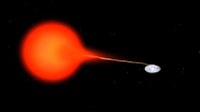
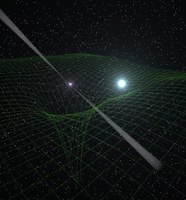

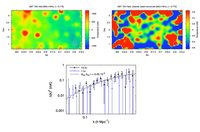
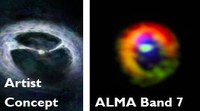
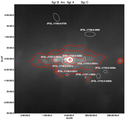



Connect with NRAO